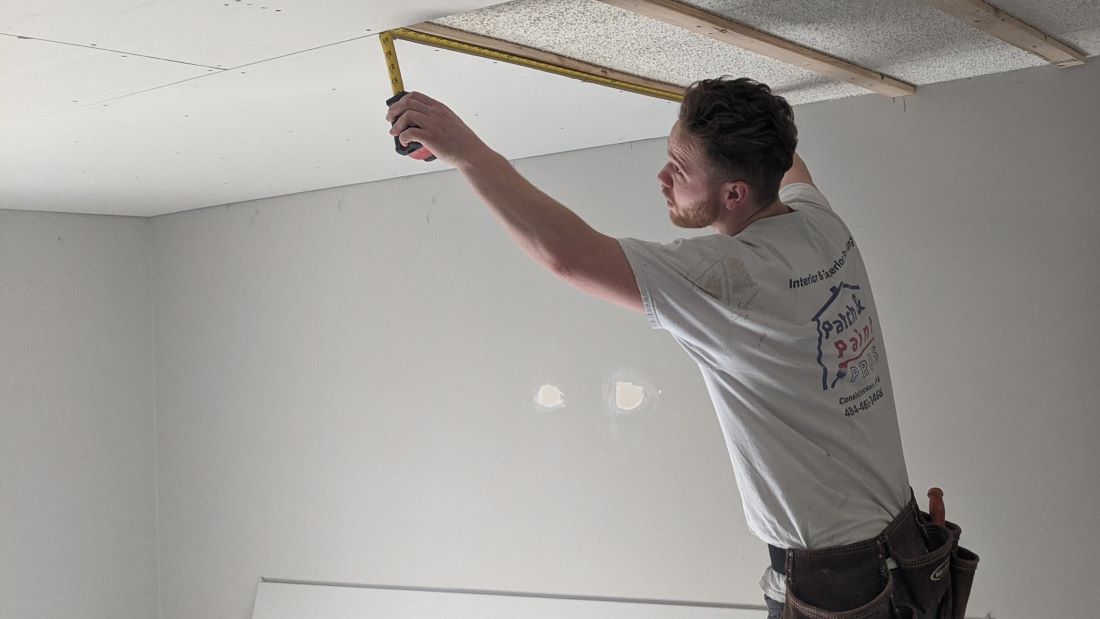Paint is an important part of any home improvement project, but it can be a daunting task to remove paint from metal surfaces. If you’re looking for the best way to get rid of those stubborn spots and streaks, professional house painters have some advice on how they do it. With their expertise in painting, these professionals know what works best when it comes to tackling tough projects like removing paint from metal. Read on to find out more about the tips that house painters use to make this chore easier.
Removing paint from metal doesn’t need to be difficult or messy; with the right tools and techniques, anyone can tackle this job successfully. Professional house painters take extra care when taking off old layers of paint so that new ones will adhere properly. They also know which products are most effective and safe for both painted surfaces and your health. With their knowledge and experience, professional house painters can help you easily prep any surface for repainting or refinishing without harsh chemicals or toxic fumes.
By following the tips shared by experienced house painters, you’ll be able to remove paint from metal quickly and efficiently — no matter if it’s been there for years or just days! In this article, we will discuss the steps involved in removing old coats of paint from metals as well as share their tips on getting the job done properly while avoiding costly mistakes along the way. Keep reading to learn more about professional house painters’ best practices for tackling this tricky task!
Understanding The Different Types Of Paint Removal
When it comes to painting, it’s important to consider the potential impact on our health and the environment. That’s why more and more people are opting for nontoxic paints, which are safer and more eco-friendly. Removing paint from metal requires patience and the right tools to ensure that you get every bit of it off without damaging the underlying surface. If you’re looking for the best way to remove paint from metal, whether it’s steel, aluminum, or cast iron, professional house painters have some tips that can help.
First, there are several different types of paint removal methods available; wire brushes, putty knives, and chemical agents such as paint thinners are all effective at removing most paints. Wire brushes work well for smaller jobs where only a few layers of paint need to be removed. Putty knives can be used on larger surfaces when scraping away thick layers of old paint. And finally, chemical agents such as paint thinners are often needed to break down stubborn coatings and sealers before attempting any other type of removal method.
No matter which technique you choose to use, it’s important to take your time and do the job correctly to minimize damage to the underlying surface. This means properly preparing the metal with sandpaper or abrasive pads before starting any kind of removal process so that no scratches or nicks occur during the procedure. With a little bit of preparation and the right tools, almost anyone can learn how to effectively remove paint from metal in their own home. Ready for the next step? Preparing the metal surface for paint removal is essential in ensuring good results!
Preparing The Metal Surface For Paint Removal
Before beginning the process of paint removal, it’s important to understand what type of paint is on the metal surface. Lead-based paints can be hazardous and require special handling during removal. If you’re unsure of what kind of paint has been used, consult a professional for safety precautions.
Once you’ve determined that the paint isn’t lead-based, there are three main methods for removing it from metal surfaces: wire wheels, putty knives, and chemical agents. A wire wheel mounted onto an electric drill is a great tool for quickly removing large amounts of paint. It works by grinding away at the layers until they come off in pieces or flakes. Putty knives work well when scraping away thick layers of old paint buildup; these should only be used on larger surfaces as they may cause scratches if not handled correctly. Chemical agents like ordinary household detergent or solvent-based strippers are also effective at breaking down stubborn coatings and sealers before attempting any other type of removal method.
No matter which technique you choose to use, proper preparation is essential in ensuring good results with minimal damage to the underlying surface. This means sanding down rust spots with fine-grit sandpaper and wiping away dirt and dust particles using a damp cloth before starting any kind of removal process so that no scratches or nicks occur during the procedure. With just a little bit of time spent preparing the metal surface beforehand, anyone can learn how to effectively remove paint from metal without damaging their project!
Safety Considerations For Removing Paint From Metal
Ah, paint removal: the bane of every homeowner’s existence! It’s a messy and time-consuming process that requires patience and safety precautions. Before attempting to remove any kind of paint from metal surfaces, it’s important to remember one key thing – safety first! That means wearing eye protection, working in a well-ventilated area, and using chemical rust removers only when necessary.
For those looking for an easier method of removing paint from metal, there are a variety of tools available on the market today. Paint scrapers come in different shapes and sizes and can be used to scrape away layers of old coatings with ease. Chemical strippers also work great at breaking down stubborn sealants without damaging the underlying surface too much. However, these should always be handled carefully as they contain toxic chemicals that could harm you if not handled properly.
Lastly, wire wheels mounted onto electric drills make quick work of large areas where thick layers of paint have built up over time. These tools grind away at the layers until they come off in pieces or flakes and require minimal elbow grease to get results. With so many options available for tackling this tedious task, anyone can learn how to effectively remove paint from metal without sacrificing their sanity (or their health!) in the process.
Selecting The Right Tool Or Product For The Job
When it comes to removing paint from metal, the right tool or product will depend on what kind of paint has been applied. Oil-based paints are difficult to remove and require special solvents such as mineral spirits to break down the tough sealant. For these types of paints, a wire brush attachment for an electric drill is usually the best bet. The brush spins at high speed, breaking up and separating layers of old coating quickly and easily.
On the other hand, water-based paints can be removed with much less effort using chemical strippers that contain fewer harsh chemicals than their oil-based counterparts. When selecting a chemical stripper, make sure it’s designed specifically for use on metal surfaces; otherwise you could damage the underlying surface while attempting to remove the paint. Additionally, take care not to let any residue remain behind after painting removal is complete by wiping off any remaining solvent or stripper before proceeding with further steps.
Once you have chosen the right tool or product for your project, it’s time to move forward with applying it to the metal surface. It’s important to follow directions carefully when working with hazardous materials like chemical strippers and solvents to ensure the safe completion of your task at hand.
Applying The Paint Stripper To The Metal Surface
Putting the paint stripper to work on a metal surface can be an intimidating task, but with some careful preparation and attention to detail, it’s reasonably straightforward. To begin, make sure the area is well-ventilated and wear protective clothing such as gloves, glasses, and a mask if necessary. Then prepare a solution of household detergent and warm water in a bucket – this will help loosen any stubborn areas of old paint or debris for easier removal.
Now you’re ready to apply the paint stripper according to the instructions on the packaging. Depending on what type of product you have chosen, this may involve brushing it onto the surface using a brush or roller or spraying it from aerosol cans. Whatever method you use, keep constant pressure against the metal while working your way around all surfaces until they are completely coated with a stripper.
Once done, allow the chemical time to dissolve away layers of old coating before wiping clean with rags. Be sure to discard these items after their single-use application following local guidelines so that no hazardous materials remain behind in your home environment. With patience and diligence applied throughout this process, soon enough you’ll have removed all traces of old paint from your metal surface!
Best Way To Remove Paint From Metal According To Professionals
Professional painters know that the best way to remove paint from metal is a methodical approach. Starting with a clean surface, it’s important to prepare for the task at hand by protecting yourself and your environment – don protective clothing such as gloves and glasses, ventilates the area well, and create a solution of detergent and warm water in a bucket. Once done, applying the paint stripper according to its specific instructions will help dissolve away layers of the old coating so you can wipe them clean with rags before discarding them safely.
For harder-to-reach places on metal items, professional house painters recommend using a stiff brush or paint scraper to scrape off any stubborn areas of old coatings. In doing so, be sure to move slowly and cautiously since it’s easy to cause scratches or damage when working against metal surfaces. If necessary, use additional coats of chemical strippers over time while taking breaks between applications to avoid prolonged contact with corrosive substances.
Once finished scraping away all traces of old paint residue, take extra measures if needed by sanding down any remaining imperfections until you achieve an even finish across the entire surface. With this thorough approach taken into consideration, homeowners can have confidence that their painted metal objects are once again looking good as new!
Common Mistakes In Removing Paint From Metal
Understandably, homeowners may feel overwhelmed when it comes to removing paint from metal. However, some common mistakes should be avoided if you want the best results. First and foremost, always remember to wear protective goggles and gloves while working – even if you think a job is minor or harmless, any contact with chemical strippers can cause skin irritation or other health concerns.
Another mistake many people make is using wire wheel attachments on their power drills for scraping away old coatings. While this tool might seem like an easy way out of scrubbing off residue by hand, it’s not recommended since its harsh bristles can quickly damage soft metals such as aluminum or brass. Instead, use manual tools like steel wool pads and putty knives whenever possible to help avoid accidental scratches.
Lastly, one of the biggest blunders people tend to make with paint removal is skipping over the sanding process altogether; although it’s tempting to simply apply new coats directly onto surfaces without taking time to smooth them down first, doing so will likely result in unsatisfactory finishes which won’t last very long at all. To ensure your painted metal objects look great for years after they’re done being prepped correctly – take care to carefully sand all areas before applying fresh layers of coating!











